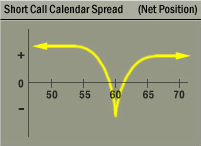Short Call Calendar Spread (Short Call Time Spread)
This strategy profits from the different characteristics of near and longer-term call options.
Description
Selling a call calendar spread consists of buying one call option and selling a second call option with a more distant expiration. The strategy most commonly involves calls with the same strike (horizontal spread), but can also be done with different strikes (diagonal spread).
Outlook
The investor is looking for either a sharp move in either direction in the underlying stock during the life of the near-term option, or a sharp move downward in implied volatility.
Summary
This strategy profits from the different characteristics of near and longer-term call options. If the stock holds steady, the strategy suffers from time decay.
If the underlying stock moves sharply up or down, both options will move toward their intrinsic value or zero, thus narrowing the difference between their values. If both options have the same strike price, the strategy should always receive a premium when initiating the position.

EXAMPLE
- Long 1 near 60 call
- Short 1 far 60 call
MAXIMUM GAIN
- Net premium received
MAXIMUM LOSS
- Unlimited
Motivation
The investor hopes to profit from a sharp move in the stock price.
Variations
The strategy described here involves two calls with the same strike but a different expiration, i.e. a horizontal spread. A diagonal spread, involving two calls with different strikes as well as expirations, would have a slightly different profit/loss profile. The basic concepts, however, would continue to apply.
Max Loss
The maximum loss would occur should the underlying stock remain steady. If at the first expiration the stock is at the strike price of the expiring option, that option would expire worthless while the longer-term option would retain much of its time premium. In that situation, the loss would be the cost of buying back the longer-term option less the premium received when the position was initiated. If the near-term option expires worthless and the investor takes no action, the strategy becomes a naked call and there is no limit to the potential loss.
Max Gain
The maximum gain would occur should the two options reach parity. This could happen if the underlying stock declined enough that both options became worthless, or if the stock rose enough that both options went deep in-the-money and traded at their intrinsic value. In either case, the gain would be the premium received when the position was initiated.
Profit/Loss
The potential profit is limited to the extent the near-term option gains more quickly, or declines more slowly, in value than the longer-term option. During the life of the near-term option, the potential loss is a function of implied volatility, and a sharp spike higher could cause substantial losses. If the position is held beyond the expiration of the near-term option, however, the strategy becomes simply a naked call with no possibility of further profit and the potential for unlimited losses.
Breakeven
Since the options differ in their time to expiration, the level where the strategy breaks even is a function of the underlying stock price, implied volatility and rates of time decay.
Volatility
An increase in implied volatility, all other things equal, would have an extremely negative impact on this strategy. In general, longer-term options have a greater sensitivity to changes in market volatility, i.e., a higher Vega. Be aware, however, that the near and far-term options could and probably will trade at different implied volatilities.
Time Decay
The passage of time, all other things equal, would have a very negative impact on this strategy. In general, an option's rate of time decay increases as its expiration draws nearer.
Assignment Risk
Early assignment, while possible at any time, generally occurs for a call when the stock goes ex-dividend. Should early exercise occur, using the the near-term option to cover the assignment (assuming it has not expired) would require establishing a short stock position for one business day.
And be aware, a situation where a stock is involved in a restructuring or capitalization event, such as a merger, takeover, spin-off or special dividend, could completely upset typical expectations regarding early exercise of options on the stock.
Expiration Risk
Expiration risk for this strategy would occur when the longer-term option expires. The greatest risk for this strategy emerges after the near-term expiration, when the strategy becomes a naked call. By comparison, the risk of being unexpectedly assigned when the longer-term option finally expires seems somewhat trivial.
Comments
The difference in time to expiration of these two call options results in their having a different Theta, Delta and Gamma. Obviously, the near-term call suffers more from time decay, i.e., has a greater Theta. Less intuitively, the near-term call has a lower Delta but a higher Gamma (if the strike is at-the-money). This means that if the stock moves sharply higher, the near-term call becomes much more sensitive to the stock price and its value approaches that of the more expensive longer-term call.
Related Position
Comparable Position: Short Put Calendar Spread
Opposite Position: Long Call Calendar Spread

